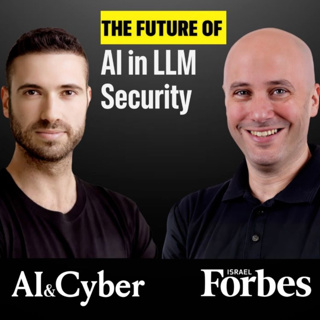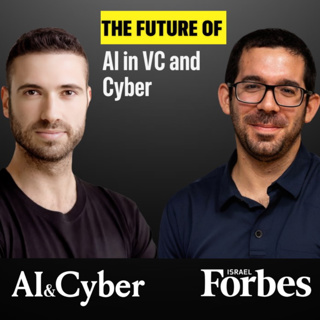
AI and the End of Traditional Cybersecurity: A Conversation with Barak Schoster
Cybersecurity is at a turning point, largely driven by rapid advancements in artificial intelligence (AI). My recent conversation with Barak Schoster—a renowned cybersecurity expert and entrepreneur—highlighted AI’s profound impact on the field. Schoster, who founded Bridgecrew (now part of Palo Alto Networks), has extensive experience in advanced threat protection and innovative security solutions.AI’s Role in CybersecuritySchoster put it simply: “The boundaries have been broken.” Traditional security methods, such as endpoint protection and perimeter-based defenses, are no longer enough in an era dominated by cloud computing and fast-moving data. By 2025, Gartner predicts that 85% of enterprises will primarily operate in cloud environments, demanding proactive and adaptive security models.Emerging ChallengesOrganizations are increasingly using cloud platforms and SaaS applications, introducing new risks. AI-driven productivity tools, while boosting efficiency, also heighten vulnerabilities—through unintended data leaks and unsecured exchanges. Employees frequently use tools outside corporate oversight, raising serious security concerns. Schoster noted that open-source adoption accelerates software distribution but requires strategic monetization. “We moved from single-player mode, where developers benefited individually, to multiplayer mode, which brought real enterprise value,” he explained.AI’s Double-Edged ImpactAI both expands the attack surface and enhances defense capabilities. Schoster pointed out that deepfakes and automated phishing campaigns have significantly lowered the cost and complexity for cybercriminals. However, AI-powered security tools can automate complex tasks, improving efficiency and resilience.The urgency is clear: AI-driven phishing attacks have increased by over 2,000% in the past year alone, according to Team8. This escalation highlights the need for real-time security interventions. Bridgecrew leveraged AI for instant monitoring and security enforcement, shifting cybersecurity from reactive threat detection to proactive prevention.The Future of CybersecurityThis transformation reflects a larger industry shift. AI can dramatically reduce vulnerabilities, minimize false positives, and enhance productivity by automating critical security tasks—allowing experts to focus on strategic objectives. Schoster predicts that static defenses and perimeter-based models will soon be obsolete. “Execution, speed, and adaptability have become more important than traditional moats like IP or patents,” he asserted.Organizations must embrace AI-powered security strategies or risk being replaced by more agile competitors. As Schoster warned, “Those that fail to adapt quickly enough will inevitably be replaced by innovative, AI-driven newcomers.” The future of cybersecurity depends on agility, automation, and a forward-thinking approach.
5 Maj 43min
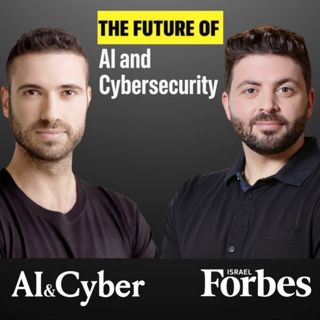
How AI is Shaping the Future of Cyber: A Conversation with Liran Grinberg, Co-founder of Team8
Cybersecurity today is more dynamic and critical than ever, thanks to the transformative influence of AI. Liran Grinberg, Co-founder of Team8, highlighted this evolution in a recent discussion. Drawing on his experience from Israel's elite Unit 8200 and managing over $1 billion in ventures, he shed light on how AI is reshaping cybersecurity. He emphasized that AI isn't just enhancing existing technologies but enabling previously impossible capabilities, which also broadens the attack surface—creating both new vulnerabilities and opportunities for innovation.Grinberg's perspective resonated with my own observations at Clarity, where AI has expanded the threat landscape while revolutionizing defense capabilities. Traditional reactive models are becoming outdated. Analysts are now evolving into supervisors of AI-driven agents managing operational tasks, which showcases how AI integration can bolster cybersecurity effectiveness. This shift is essential, particularly given the increasing complexity and sophistication of threats, such as AI-driven phishing and deepfakes.Speed and momentum are critical in the competitive world of cybersecurity. Grinberg pointed out the necessity for rapid, responsible decision-making to secure market leadership. This aligns with Clarity's approach, where staying ahead of threats is not optional but a mandate for survival. He also emphasized the enduring need for domain expertise, particularly when integrating complex AI solutions into cybersecurity strategies. Without such expertise, even the most advanced tools risk being ineffective.Grinberg's outlook underscores the need for proactive, predictive, and preventive strategies in cybersecurity. At Team8, their AI Excellence Center exemplifies this by focusing on deep, strategic AI integration rather than surface-level adoption. The accelerated adoption of AI presents unmatched opportunities but also escalates risks for those lagging behind.The message is clear: embracing AI-driven cybersecurity is no longer optional. Organizations must prioritize strategic AI integration to ensure resilience and efficiency in an increasingly complex threat environment. As Grinberg said, the future of cybersecurity is dynamic, proactive, and deeply intelligent. Those who delay risk falling dangerously behind.
5 Maj 54min
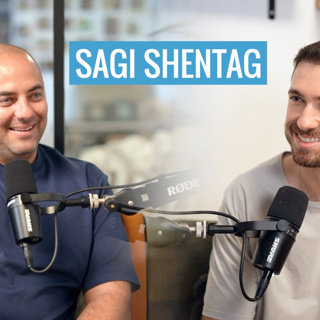
Ep1140: Sagi Shentag: Scaling Global Connectivity
After years in finance and a move from New York back to a kibbutz, Sagi Shentag led Tango from startup to $300M revenue before taking the helm at VOY. Now, he’s transforming global connectivity by making travel data seamless, affordable, and stress-free—turning a complex necessity into a simple, empowering experience.#20MinuteLeaders #GlobalConnectivity #TravelTechInnovation #EntrepreneurialJourney
4 Maj 21min
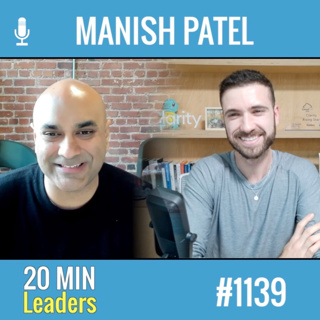
Ep1139: Manish Patel: Navigating AI Chaos for Growth
Growing up between Uganda, the UK, and rural Kentucky, Manish Patel’s journey led him from Stanford to Google and then into venture capital. Reflecting on technology’s human impact, Manish shares how today’s AI-driven chaos mirrors past moments of innovation—and why building around human needs, not just features, will define the next generation of companies.#VentureCapital #AIInnovation #StartupMindset
28 Apr 21min
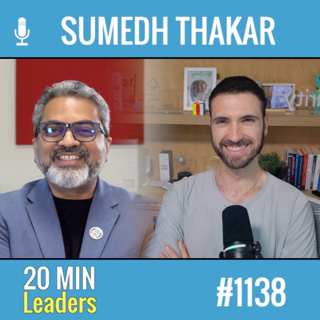
Ep1138: Operationalizing Cyber Risk with Sumedh Thakar
Sumedh Thakar, CEO of Qualys, delves into his journey from software engineer to cybersecurity leader, stressing the critical role of risk quantification in protecting business value. He highlights the dynamic nature of cybersecurity, tackling challenges like AI and quantum security, while offering insights into aligning security efforts with financial impact for long-term resilience.#CyberRiskManagement #CybersecurityLeadership #RiskQuantification #InfoSecStrategy #20MinuteLeaders
24 Apr 23min
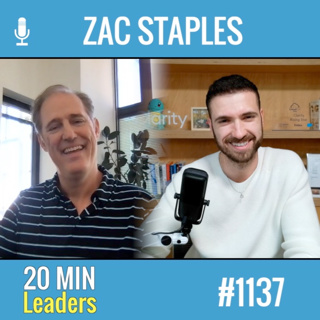
Ep1137: Zac Staples on AI for Naval Readiness
A childhood love of tractors and a Navy career shaped Zac Staples’s path to founding Fathom5, the first company to deploy AI on a naval warship. In this episode, he shares how he's tackling the overlooked world of industrial machines—building platforms that bring AI to legacy systems powering national security and daily life. With a focus on trust, machine resilience, and sustainability, Zac offers a grounded, thoughtful perspective on modernizing critical infrastructure in an AI-driven age.#AIinDefense #MachineTrust #CriticalInfrastructure
10 Apr 22min
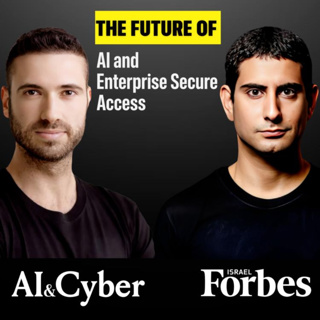
AI Revolution in Browser Security: Insights from Ofer Ben-Noon, CTO of SASE at Palo Alto Networks
By Michael Matias, CEO of Clarity and Forbes 30 Under 30 alumCybersecurity is at a pivotal crossroads, transformed by AI and the realities of hybrid work. In my recent conversation with Ofer Ben-Noon—founder of Talon Cyber Security and former CEO of Argus Cyber Security—it became clear that traditional cybersecurity strategies must evolve, especially as the browser becomes the primary gateway to enterprise data.With a background in Israel’s elite Unit 8200 and as a pioneer in automotive cybersecurity, Ben-Noon now leads Talon in redefining how organizations secure today’s decentralized workforce. His focus? The secure browser.“Control the browser, and you control the data,” he said. That simple yet powerful insight underpins a massive shift in cybersecurity thinking. As workers increasingly access corporate systems from personal or unmanaged devices, legacy defenses like firewalls and VPNs fall short. Ben-Noon, now also CTO of SASE at Palo Alto Networks, pointed out that 90% of enterprises allow access from unmanaged devices—and 85% of ransomware attacks stem from them.This challenge is compounded by SaaS sprawl. While companies officially use about 1,500 apps, they often have up to 8,500 unsanctioned ones operating in the shadows. This explosion of shadow IT, paired with the rise of AI, introduces massive vulnerabilities. Every day, Palo Alto Networks sees 7.7 million new malicious URLs and countless AI-generated malware strains. “AI dramatically accelerates both the complexity and volume of threats,” Ben-Noon warned.Yet, AI is also a powerful ally. Talon’s secure browser integrates AI-driven security directly into everyday workflows—no more clunky, bolt-on tools. This innovation transforms the browser from a weak point into a flexible, secure productivity hub. “The browser itself becomes the center of secure productivity—empowering users rather than limiting them,” he explained.I couldn’t agree more. Today’s workforce values autonomy and speed. A secure browser gives teams both, while protecting critical data in real time. Ben-Noon emphasizes proactive AI-driven defenses over reactionary ones: detecting breaches after the fact isn’t enough anymore—prevention is key.In closing, Ben-Noon shared, “We’ve made significant bets on three trends: distributed workforces, web-based applications, and the Chromium browser as the dominant digital workspace.” These trends, rapidly accelerated by AI, demand a fresh cybersecurity mindset.The organizations that embrace this shift—integrating AI and secure browsers into their DNA—will be the ones best equipped to thrive in an increasingly complex digital world.
26 Mars 37min
